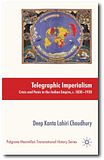Telegraphic Imperialism
Lahiri Choudhury, Deep Kanta
Telegraphic Imperialism : Crisis and Panic in the Indian Empire, c.1830-1920 / Deep Kanta Lahiri Choudhury. - Basingstoke : Palgrave Macmillan, 2010. - ca. 296 S. - (The Palgrave Macmillan Transnational History Series)
ISBN 978-0-230-20506-2
£ 55,00
DDC: 384.1095409034
-- Angekündigt für Oktober 2010 --
Beschreibung
Telegraphic Imperialism researches the telegraph system of the British Indian Empire, circa 1830 to 1920, exploring one of the single most significant transnational phenomena of the imperial world, and the link between communication, Empire, and social change. The first electronic communication network, the predecessor of our internet, transformed language, distance, and time. Lahiri Choudhury studies this transnational system and how societies and perceptions changed because of the telegraph, including the issue of Persian sub-imperialism and the rapid expansion of the imperial powers and their rivalries because of the need to protect and control this new information network. The book also analyses in detail British Imperialism and the variety of strategies adopted by Indian nationalists to circumvent imperial control.
During this period the British Indian Empire emerged as a crucial strategic and commercial factor in the telegraph network of the world. Larger India became a communication hub, and relatively remote points such as Fao and Gwadar were transformed from sleepy townlets and fishing villages in Middle Asia into crucial nodes of the Indian Empire. This network serviced trade and communication across nations, territories, and empires from the Americas to the Russias, China, and Australasia including Taiwan and New Zealand. In the present age of rapid and competitive technological advancement, the study of communication history is becoming essential for our better understanding of the nature of the development involved. This book provides a step towards this understanding. [Verlagsinformation]
Inhalt
List of Illustrations. viii
Foreword. ix
Acknowledgements. xi
List of Abbreviations. xii
Introduction: "What hath God wrought!". 1
1. From Laboratory to Museum: the Changing Culture of Science and Experiment in India, circa 1830-1856. 11
2. The Telegraph and the Uprisings of 1857. 31
3. The Discipline of Technology. 50
4. Making the Twain Meet: the New Imperialism of Telegraphy. 79
5. The Magical Mystery Tour: Cable Telegraphy. 105
6. Forging a New India in a Telegraph World: Expansion and Consolidation within India. 129
7. The Telegraph General Strike of 1908. 157
8. Swadeshi and Information Panic: Functions and Malfunctions of the Information Order, c.1900-1912. 179
Conclusion. 211
Notes. 219
Glossary. 257
Bibliography. 258
Index. 271
Autor
DEEP KANTA LAHIRI CHOUDHURY trained in history at Presidency College, Jawaharlal Nehru University, India, and University of Cambridge, UK. He did his Post-Doctorate at University of Oxford. He has taught, lectured and supervised at various institutions including Cambridge, Oxford, Bristol, Jamia Millia Islamia and Visva Bharati, Shantiniketan, as well as published in various international journals. Profile page (Jamia Millia Islamia).
Quellen: Palgrave; WorldCat; Library of Congress; Amazon (UK)
Ähnlich
- Communication and Colonialism in Eastern India
- Llewellyn-Jones: Last King in India
- After Timur Left
- Sohi: Echoes of Mutiny
- Fischer-Tiné: Shyamji Krishnavarma
- Soldat Ram Singh und der Kaiser
- India and Europe in the Global Eighteenth Century
- Biedermann: The Portuguese in Sri Lanka and South India
- Cederlöf: Founding an Empire on India's North-Eastern Frontiers
- Kingship in Kaśmīr (AD 1148–1459)

